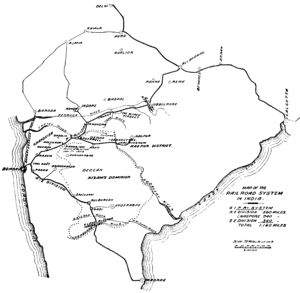Difference between revisions of "Great Indian Peninsula Railway"
HughWilding (talk | contribs) m |
HughWilding (talk | contribs) (Added new category) |
||
| Line 1: | Line 1: | ||
| − | |||
[[Image:Giprlogo.jpg|right]] | [[Image:Giprlogo.jpg|right]] | ||
| Line 42: | Line 41: | ||
1 "Money Market and City Intelligence", ''The Times'', Wednesday, 15 June 1859, #23333, 7a. | 1 "Money Market and City Intelligence", ''The Times'', Wednesday, 15 June 1859, #23333, 7a. | ||
| + | |||
| + | [[Category:Railways]] | ||
| + | [[Category:Guaranteed Railways]] | ||
Revision as of 22:33, 30 November 2008
Like most of the early railways in India, the Great Indian Peninsula Railway (GIPR) was a British company, registered in London, privately owned and financed, operating under license and guarantee from the (British) Board of Control in India and the East India Company (EIC).
By 1859, GIPR was tasked with "the construction and working of the following lines, all of which terminate at Bombay, - viz. from Bombay, via Callian, to Jubbulpore, to meet the East Indian Railway Company's line from Allahabad, with branches to Mahim and Nagpore - 870 miles; and from Callian, via Poonah and Sholapore, to the opposite side of the river Kristna, to mmet the line, via Bellary, from Madras - 366 miles - total, 1,236 miles. Capital 10,000,000ll. Rate of Interest Guaranteed - 5 per cent. on 8,000,000l. capital, and 4½ per cent. on 333,000l. debentures, the balance to be raised upon arrangements to be hereafter made." (1)
Characteristics
Formed in 1845, it was not until 1849 (at the urging of the then Governor, Lord Dalhousie) that the EIC sanctioned the GIPR to construct an experimental line eastward from Bombay. The first sod was turned on 31 October 1850 and the first locomotive was used in construction on 22 December 1851, but the first passenger train in India did not run until 16 April 1853, when a train, with 14 railway carriages and 400 guests, left Bombay bound for Thane, hauled by three locomotives: Sindh, Sultan, and Sahib. The 21 mile journey took an hour and fifteen minutes over the first section of the GIPR to be opened.
When, in 1871, the GIPR eventually reached Jubbulpore and linked to the East India Railway (EIR), it completed Dalhousie’s dream of a Bombay-Calcutta route.
On 30 June 1900, the assets of the GIPR were purchased by the GoI while the management remained in private hands. On 1 July 1925, the GoI took over direct control of the GIPR. In 1951, the GIPR combined with the Nizam's State Railway, the Dholpur State Railway and the Scinde State Railway to become Indian Railway's Central Railway.
Records
The following are held in the India Office Records at the British Library.
- L/AG/46/12/86 : GIPR Lists of appointments (officers 1849-1885; workmen 1852-1880)
- L/AG/46/12/88 : GIPR Contracts of employment (officers 1886-1925; workmen 1881-1925)
Both of the above are indexed in
- Z/L/AG/46 : Index to UK Appointments to Indian Railways (1849-1925)
External Links
Great Indian Peninsula Railway logo
Science & Society Picture Library
Notes
1 "Money Market and City Intelligence", The Times, Wednesday, 15 June 1859, #23333, 7a.

